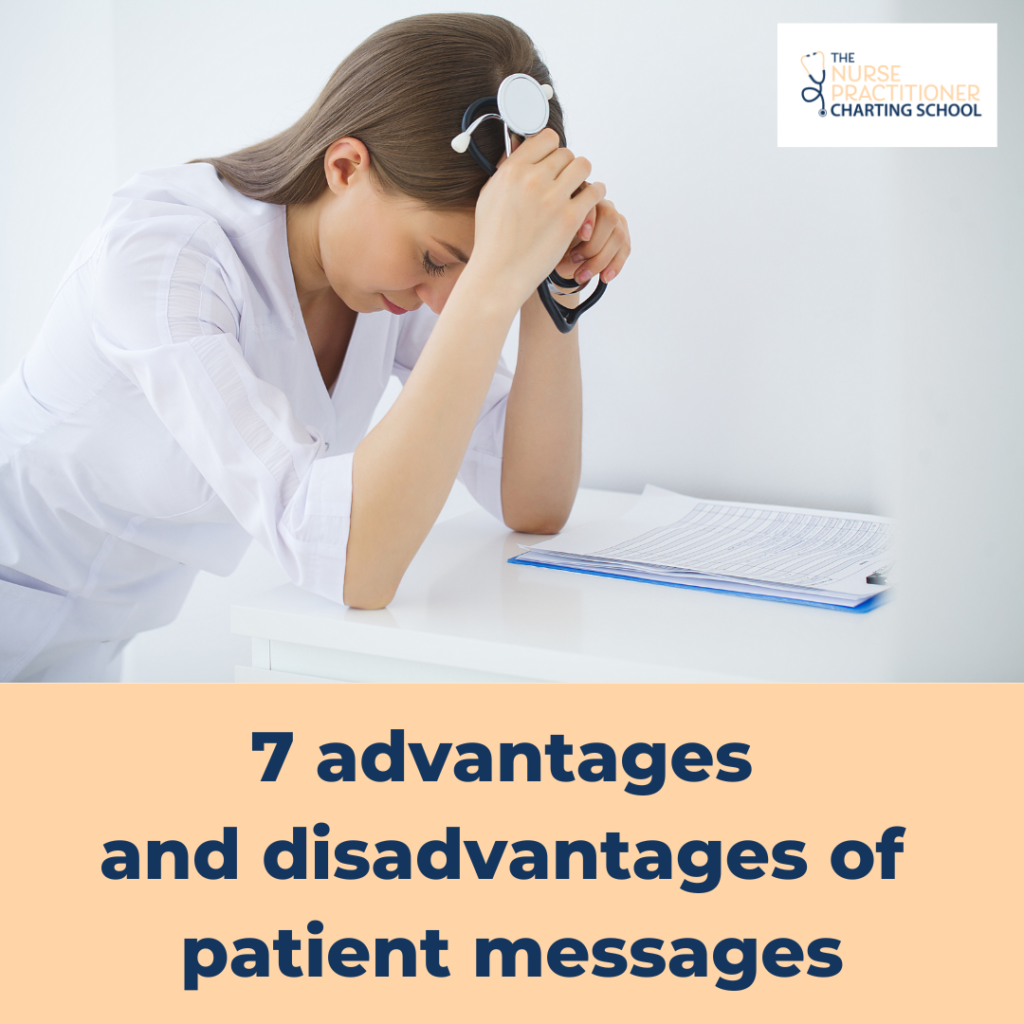Ohhhhh the dreaded patient messages.
This is one of the most time consuming and frustrating tasks a nurse practitioner has to do. Nurse practitioners spend a lot of precious time reading and replying to patient messages. And it seems like the messages are never ending!
Yet there are several benefits of patient messages for both the patient and the provider. We will take a look at a few advantages and disadvantages of patient messages.
What are patient messages?
Many electronic health records (EHR) allow patients to send a message to their provider through their patient portal. This is similar to emailing or sending a text message through a secure platform. Patients used to be able to access or ask questions to their nurse practitioner through phone calls (and some patients still do this).
Messages may range from wondering when their last Tdap vaccine was administered, to double checking what the nurse practitioner had said for education instructions, to a new onset symptom that the patient is worried about. The patient messages can be very time consuming and are one of top tasks (besides charting itself) that consumes the nurse practitioner’s time.
While it may seem like there are a lot of disadvantages of patient messages, there are also some advantages to this kind of access.
Advantages of patient messages
Increased access to the nurse practitioner
It is very convenient to write a message to your nurse practitioner and have it answered within a few hours (but it’s never a few hours when nurse practitioners have dozens of messages to address). In this modern world of technology, it makes sense to have this kind of access. Nurse practitioners can quickly answer these questions and put the patient’s mind at ease.
Improve patient-provider relationships
It also helps the nurse practitioner to get a quick update of how the patient is feeling or that their blood sugars are improving. Many nurse practitioners strive to frequently check up on their patients. A lot of nurse practitioners worry about their patients outside of work and patient messages are a quick way to check in with the patient.
Decrease in support staff responsibilities.
Patient messages help to decrease the amount of phone calls the healthcare institution receives. With the current world experiencing short-staffing in multiple industries (healthcare included) this is actually a positive of patient messages.
It takes less time for the patient and the provider to interact. No more calling the clinic and getting placed on hold until the front office staff can take a message and then have the nurse or nurse practitioner call the patient back. We all know how much time it can take to play phone tag with patients.
Disadvantages of patient messages
Decrease in revenue generated
One of the disadvantages of patient messages is that patients no longer feel like they need to schedule an appointment for every complaint. For example, messages from a patient may be about a new rash with questions about what kind of cream they can put on there. Maybe the patient has symptoms of dysuria and is requesting an antibiotic. Maybe the patient messages about a routine medication and needs a refill today before they run out. This creates several disadvantages of patient messages.
Patient messages are not meant to replace a clinic visit. Remember that the function of a nurse practitioner is to assess, diagnose, treat, and document findings. This is how we bill a patient’s insurance. This is how we generate revenue for the healthcare business. We have to remember that healthcare is a business and businesses need to generate revenue in order to sustain.
Nurse practitioners should feel empowered to do their part with revenue generation. They should strive to ensure they are increasing or sustaining RVUs and not losing out on money through patient messages.
Think about addressing a patient’s acute or chronic illness via the patient messages function. Maybe the nurse practitioner sent a prescription instead of having the patient come in for a visit. If the nurse practitioner does this one time per day, that is an average of $100 of lost revenue. Add that up over a week, a month, a year, and that is a lot of lost revenue. This creates significant disadvantages of patient messages.
Barriers to effective communication.
A breakdown in effective communication can increase risk for liability. I do not want nurse practitioners to stress about being sued (more info in Legal Issues with Charting Course). But we do need to be aware of how to prevent a negative outcome in a malpractice case. And one of the ways is to ensure proper communication.
The issue with patient messages is that it creates barriers to proper communication. Maybe the patient mistyped their blood pressure in the patient messages (the patient typed 129/89 instead of 199/89). Or maybe the patient requested a routine medication refill but misspelled the name of the med, confusing the nurse practitioner.
Without talking to the patient on the phone or seeing them in person, the nurse practitioner cannot see the patient’s nonverbal communication which can create a breakdown in communication. This is one of the serious disadvantages of patient messages.
I do like patient messages in the fact that whatever is typed is documented into the patient chart. It proves that the nurse practitioner gave plan of care instructions or notified the patient of possible medication side effects. It proves the work that the nurse practitioner did.
I’m not saying the patient messages should not be utilized, but it is just something we need to address the disadvantages of patient messages.
Patient messages are not instant.
Many patients are under the impression that these patient messages will be addressed instantaneously (or at least within a few hours). This can create frustration for the patient when they do not get a reply back for 24 hours (or longer).
Or maybe it is a serious, potentially life threatening symptom (such as chest pain or shortness of breath) that they notified the nurse practitioner via patient message. If the complaint does not get addressed for 24 hours this can create negative outcomes for both the patient and the nurse practitioner.
The nurse practitioner can potentially be held liable even if the provider did not view the patient message in a timely manner. A malpractice lawyer would argue that the patient had notified the nurse practitioner and the proper action was not taken. This is one of the serious disadvantages of patient messages.
Or maybe the pharmacy called to clarify a dose of medication and the nurse practitioner did not have a chance to look at the message before the patient picked up the medication. The not so instant messaging creates disadvantages of patient messages and to patient care.
Consumes the nurse practitioner’s time.
Many healthcare institutions have practices in place for addressing patient questions via telephone. Many healthcare facilities have a streamline process for nurses or medical assistants to first answer any questions via phone calls. If the nurse/MA is unable to answer the question, they will pass it along to the nurse practitioners. This has been the generalized process for many years.
But it seems like with the increase and convenience of access to the nurse practitioners, patient messages have gone up. Some healthcare facilities have support staff address messages. But sometimes the nurse practitioner ends up with more messages to respond. This is essentially adding on another task to a nurse practitioner’s already busy day.
Nurse practitioners already struggle to get their chart notes done, and now have to manage patient messages. This is causing many nurse practitioners to stay late at the office or bring their charting home. This is creating a lack of work-life balance and nurse practitioner burnout. These add up to be significant disadvantages of patient messages.
Despite these disadvantages of patient messages, this form of access is here to stay. As stated there are several advantages for both the patient and the provider. Nurse practitioners need to do their best to set boundaries with patient messages and create systems to ease the burden of patient messages.
Also check out this article on 6 tips to manage patient messages!
And read this blog post on 4 tips to manage the EHR inbox
For additional time management and charting tips, check out the Time Management and Charting Tips Course: Learn the tips and tools to chart accurately and efficiently so you can run on time during your workday, eliminate the overwhelm, leave work on time, and STOP charting at home!

Erica D the NP is a family nurse practitioner and The Nurse Practitioner Charting Coach. Erica helps nurse practitioners STOP charting at home! Erica created The Nurse Practitioner Charting School to be the one stop for all documentation resources created specifically for nurse practitioners. Learn more at www.npchartingschool.com
Follow on Facebook: The Nurse Practitioner Charting SchoolAnd on Instagram: @npchartingschool
Free training: 4 charting tips to help nurse practitioners get their time back! Sign up here!



